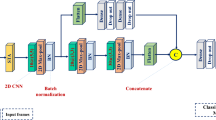Abstract
The fusion of violence detection and geographic video (GeoVideo) helps to strengthen the comprehensive dynamic perception of the objective area and better maintain social security and stability. To address the problem that the surveillance screen is fragmented from the geographic space after the occurrence of an abnormal situation in the surveillance scene by combining the positions of cameras to detect where it occurs, the violence detection and geographic video is fused to implement the visualization design. Firstly, we adopt the action detection algorithm to detect the violent actions in the video, and output the position information of the subject in the image coordinate system; then we map the position information in the image coordinate system to the world coordinate system to realize the mapping of the dynamic information obtained by the deep learning model to the static geographic space; finally, the position information of the subject is automatically marked in the remote sensing image to complete the visualization design. The results show that the fusion and visualization design of violence detection and geographic video can accurately map the location information in the surveillance screen to geographic space, which helps to grasp the global security situation of the surveillance scene.
Access this chapter
Tax calculation will be finalised at checkout
Purchases are for personal use only
Similar content being viewed by others
References
Yun-feng, K.: Research on the GeoVideo data model and its application development. Geogr. Geo-Inf. Sci. 25(05), 12–16 (2009)
Song, H., Liu, X., Lu, G., et al.: Research on enhanced expression of Geographic scene based on Video. Geogr. Geo-Inf. Sci. 28(05), 6–9+113 (2012)
Xie, X., Zhu, Q., Zhang, Y., et al.: Hierarchical semantic model of geovideo. Acta Geodaetica et Cartographica Sinica 44(5), 555 (2015)
Zhao, D., Zhang, J., Guo, C., et al.: A Survey of Video behavior recognition methods based on Deep Learning. Telecommun. Sci. 35(12), 99–111 (2019)
Cheng, S.: Research on feature extraction and recognition of Human behavior in Video sequence. Doctor, University of Electronic Science and Technology, Chengdu China (2020)
Zhu, Y., Li, X., Liu, C., et al.: A comprehensive study of deep video action recognition. arXiv preprint arXiv, 2012.06567 (2020)
Zhang, S.: Research on the method of human behavior detection and recognition in video sequence. Doctor, Huazhong University of Science and Technology, Wuhan China (2019)
Qiang, C., Yibiao, D., Haisheng, L., et al.: A Summary of Human behavior recognition methods based on Deep Learning. Comput. Sci. 47(04), 85–93 (2020)
Feichtenhofer, C., Fan, H., Malik, J., et al.: Slowfast networks for video recognition. In: Proceedings of the IEEE/CVF International Conference on Computer Vision, Seoul, Korea, 27 October–2 November (2019)
Kpüklü, O., Wei, X., et al.: You only watch once: a unified CNN architecture for real-time spatiotemporal action localization. arXiv preprint arXiv, 1911.06644 (2019)
Mo, S., Tan, X., Xia, J., et al.: Towards improving spatiotemporal action recognition in videos. arXiv preprint arXiv, 2012.08097 (2020)
Liu, L.: Research on dynamic Target Detection and behavior recognition based on Geographic constraint scene. Master, Guilin University of Technology, Guilin (2020)
Zhang, X., Liu, X., Wang, S.: Mutual mapping between surveillance video and 2D geospatial data. J. Wuhan Univ. (Inf. Sci. Ed.) 40(08), 1130–1136 (2015)
Zhang, X., Hao, X., Li, J., et al.: Fusion and visualization method of dynamic targets in surveillance video with geospatial information. Acta Geodaetica et Cartographica Sinica 48(11), 1415–1423 (2019)
Redmon, J., Divvala, S., Girshick, R., et al.: You only look once: unified, real-time object detection. In: Proceedings of the IEEE Conference on Computer Vision and Pattern Recognition, Las Vegas, USA, 27 June–29 June 2016 (2016)
Wojke, N., Bewley, A., Paulus, D.: Simple online and realtime tracking with a deep association metric. In: IEEE International Conference on Image Processing (ICIP), Beijing, China, 17–20 September 2017 (2017)
He, K., Zhang, X., Ren, S., et al.: Deep residual learning for image recognition. In: IEEE/CVF Conference on Computer Vision and Pattern Recognition (CVPR), Lag Vegas, USA, 27–29 June 2016. IEEE (2016)
Zhang, Z.: A flexible new technique for camera calibration. IEEE Trans. Pattern Anal. Mach. Intell. 22(11), 1330–1334 (2000)
Lepetit, V., Moreno-Noguer, F., Fua, P.: EPnP: an accurate O(n) solution to the PnP problem. Int. J. Comput. Vision 81(2), 155–166 (2009)
Penate-Sanchez, A., Andrade-Cetto, et al.: Exhaustive linearization for robust camera pose and focal length estimation. IEEE Trans. Pattern Anal. Mach. Intell. 35(10), 2387–2400 (2013)
Milan, A., Leal-Taixé, L., Reid, I., et al.: MOT16: a benchmark for multi-object tracking. arXiv preprint arXiv, 1603.00831 (2016)
Gu, C., Sun, C., Ross, D.A., et al.: AVA: a video dataset of spatio-temporally localized atomic visual actions. In: Proceedings of the IEEE Conference on Computer Vision and Pattern Recognition, Salt Lake City, 18 June 2017 (2017)
Author information
Authors and Affiliations
Corresponding author
Editor information
Editors and Affiliations
Rights and permissions
Copyright information
© 2021 Springer Nature Singapore Pte Ltd.
About this paper
Cite this paper
Liang, Q., Cheng, C., Li, Y., Yang, K., Chen, B. (2021). Fusion and Visualization Design of Violence Detection and Geographic Video. In: Cai, Z., Li, J., Zhang, J. (eds) Theoretical Computer Science. NCTCS 2021. Communications in Computer and Information Science, vol 1494. Springer, Singapore. https://doi.org/10.1007/978-981-16-7443-3_3
Download citation
DOI: https://doi.org/10.1007/978-981-16-7443-3_3
Published:
Publisher Name: Springer, Singapore
Print ISBN: 978-981-16-7442-6
Online ISBN: 978-981-16-7443-3
eBook Packages: Computer ScienceComputer Science (R0)





